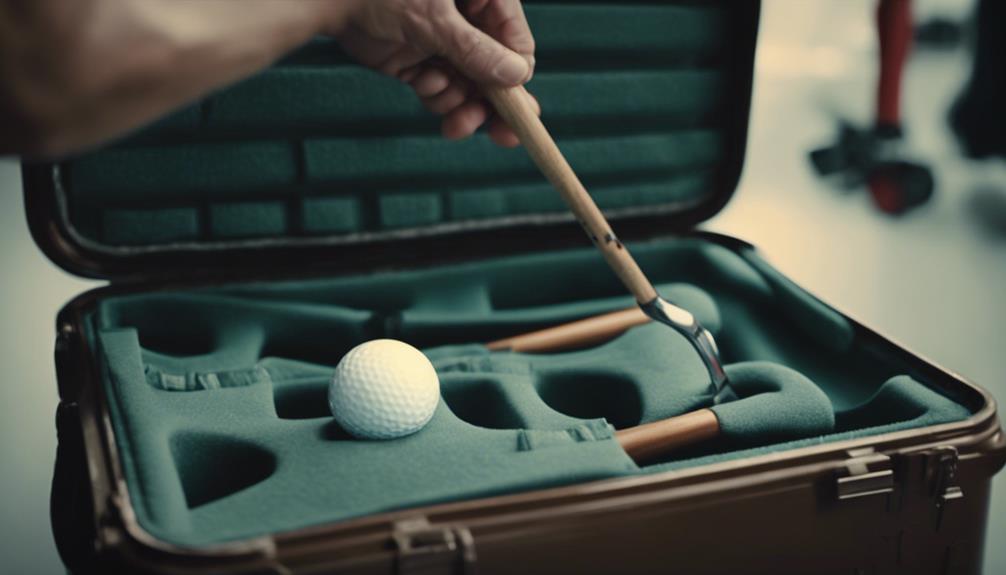- 7 Top Flite Golf Clubs XL for Improved Performance - September 28, 2024
- Top Flite Golf Clubs: Top 5 Reasons to Choose Them - September 28, 2024
- Top 3 Golf Club Fitters for a Perfect Swing - September 28, 2024
When flying with golf clubs, you'll need to check with your airline for their specific policies on oversized baggage, including maximum club length, weight, and packaging requirements. Research the airline's fees, which can range from $50 to $200 or more per flight, and consider purchasing travel insurance to protect your clubs. Choose the right case, packing your clubs safely with clothes and dividers to prevent damage. At the airport, declare your clubs as oversized baggage, providing details on weight, length, and width, and be prepared to show contents for inspection. With careful planning, you'll be teeing off in no time – and there's more to learn about making your golfing adventure a hole-in-one.
Key Takeaways
- Research the airline's policies on golf clubs as oversized baggage, including maximum length, weight, and packaging requirements.
- Choose a suitable golf club case, considering protection, weight, and storage, and document clubs before packing with clear photos.
- Pack golf clubs carefully, using a hard case, removing heads from adjustable clubs, and padding the case with clothes and dividers.
- Declare golf clubs as oversized baggage at the designated airport desk, providing details on weight, length, and width, and be prepared for inspection.
- Be aware of airline fees for oversized baggage, which can range from $50 to $200 or more per flight, and factor this into trip planning.
Check Airline Policies First
Before booking your flight, check with your airline to determine their specific policies regarding golf clubs, as some carriers have unique requirements or restrictions that may affect how you pack and transport your gear.
You don't want to show up at the airport only to find out your clubs don't meet their specifications. When researching, pay attention to details such as maximum club length, weight, and packaging requirements. Some airlines may require a hard-shell case or have specific labeling requirements.
Understanding these policies will help you prepare your golf clubs for travel and avoid any potential issues during check-in.
As you plan your golf travel, consider factoring in the airline's policies on oversized baggage. Be aware of any additional fees associated with transporting your golf clubs, and think about purchasing travel insurance to protect your gear.
Choose the Right Case
When choosing a case for your golf clubs, you'll need to decide between a soft or hard case, depending on your specific needs and preferences.
You'll want to weigh the level of protection you need, as well as the ease of transport and storage.
Case Material Matters
Choosing the right case for your golf clubs is essential, as it directly impacts the safety of your gear during travel, and selecting the appropriate material can make all the difference.
When deciding between a hard case and soft travel bags, consider your priorities. If you want peace of mind and airline coverage, a hard case might be the way to go. However, if you prioritize convenience and ease of packing, soft travel bags could be the better option.
It's vital to weigh the pros and cons of each choice carefully. Hard cases offer better protection but may be more expensive and heavier, while soft travel bags can be prone to ripping but are often more convenient.
Additionally, think about the type of vehicle you'll have at your destination – hard cases mightn't fit in smaller vehicles. If you travel frequently, a hard case that doubles as a golf bag could be a convenient and space-saving option.
Ultimately, the right case material for you'll depend on your specific needs and preferences.
Soft or Hard Case
You'll need to weigh several key factors to determine whether a soft or hard case is the best fit for your golf clubs and travel style.
When deciding between a soft or hard case, consider the level of protection you need, the weight and bulk you're willing to carry, and your budget.
Soft cases are generally lighter, more affordable, and easier to maneuver, making them ideal for frequent travelers or those with limited storage space. However, they may not provide the same level of protection as a hard case.
Hard cases, on the other hand, offer superior protection against impact, scratches, and dings, making them a great choice for valuable or high-end clubs.
They're often heavier and more expensive, but they can provide peace of mind when checking your travel case. If you're willing to invest in a high-quality hard case, it can be a worthwhile investment for protecting your gear.
Ultimately, the choice between a soft or hard case comes down to your specific needs and priorities. Consider your options carefully to guarantee you're getting the right travel case for your golf clubs.
Packing Golf Clubs Safely

To safeguard your golf clubs during transit, it's vital to pack them safely and securely in a hard case that provides adequate protection. You've invested a lot in your golf clubs, and you want to make certain they're protected during transit. A hard case that doubles as a golf bag is an excellent option, offering peace of mind and airline coverage.
Document your clubs: Take clear, high-quality photos of your golf clubs before packing them up to serve as proof of what was in the bag, and document the condition of the clubs and bag.
Protect your clubs: Remove heads from adjustable clubs and store them safely, and use a Stiff Arm or broom handle to absorb impact and prevent club damage.
Pad the case: Fill excess space in the case with clothes to pad the clubs, and use dividers or separators to prevent club damage and wrap each club individually with cloth or bubble wrap.
To guarantee your golf clubs arrive at their destination undamaged, packing them safely and securely in a hard case that provides adequate protection is essential.
Declaring Oversized Baggage
When checking in at the airport, be prepared to declare your golf clubs as oversized baggage at the designated desk, where you'll need to provide specific details about your luggage. You'll typically find signs directing you to the oversized baggage area, but if you're unsure, don't hesitate to ask airport staff for guidance.
At the desk, you'll be asked to provide information about your golf bags, including their weight, length, and width. Make sure you have this information readily available to avoid any delays. You may also be required to show the contents of your golf bag, so be prepared to open it up for inspection.
Paying Applicable Fees

After declaring your golf clubs as oversized baggage, be prepared to pay any applicable fees, which vary by airline and can add up quickly if you're not aware of them. These fees can range from $50 to $200 or more per flight, depending on the airline and the size of your cart bag.
Check with your airline: Research the airline's oversized baggage policy and fees before you fly to avoid any surprises.
Pack smart: Consider packing your golf clubs in a smaller cart bag to reduce fees, if possible.
Budget accordingly: Factor in the cost of paying applicable fees when planning your trip to verify you have enough budget for your golfing adventure.
Protecting Clubs From Damage
Safeguarding your prized golf clubs from damage is essential, as a single mishap can render them useless and leave you frustrated on the course.
You've invested time and money into selecting the perfect set, so it's vital to take extra precautions when transporting them.
When packing your clubs, make sure to wrap each club head individually with a soft material, such as a towel or cloth, to prevent scratching and dents. This simple step can save your clubs from damage caused by friction and impact.
Additionally, consider investing in a high-quality club head cover or travel case specifically designed for golf clubs. These cases are built to absorb shocks and protect your clubs from external forces that could cause damage.
Airport Check-In Procedures

Before you head to the airport, you must familiarize yourself with the airline's specific golf club baggage policy to avoid any surprises at check-in. Check with the airline to see if they've any specific requirements, such as using a hard-sided case or having a maximum weight limit. This will confirm you're prepared and avoid any last-minute issues.
Arrive early: Get to the airport with plenty of time to spare in case there are any issues with checking your golf clubs.
Remove loose items: Take out any loose items from your golf bag, such as golf balls, tees, and ball markers, and pack them in your regular luggage to avoid overweight charges or loss.
Check at the designated area: Consider checking your golf clubs at the designated oversized baggage area, rather than at the regular check-in counter, to guarantee they're handled properly.
Dealing With Lost or Damaged Clubs
When you arrive at your destination and discover that your golf clubs are damaged or lost, don't panic – you've got a process to follow to get compensation.
You'll need to report the issue to the airline right away, providing detailed descriptions and photos of the damaged clubs.
Reporting Damage
You'll need to act fast if your golf clubs are lost or damaged during transit, as airlines and shipping companies typically have strict time limits for reporting damage. The sooner you report the issue, the better your chances of getting compensation or a replacement.
When reporting damage, make sure to document everything: take clear, high-quality photos of the damaged clubs and any damage to the case or bag. This will serve as evidence when filing a claim.
Keep all original packaging, including the box, wrapping materials, and any labels. This will help prove that the damage occurred during transit.
Retain your golf towel if it was packed with your clubs, as it can help support your claim.
Remember to stay calm and be thorough when reporting damage. Take your time to gather all necessary information and evidence, and you'll be well on your way to resolving the issue.
Filing a Claim
Filing a claim for lost or damaged golf clubs requires prompt action and meticulous attention to detail, as airlines and shipping companies typically have strict protocols in place to handle such incidents.
You'll need to gather documentation, including your ticket receipt, baggage claim tags, and proof of the club's value. Be prepared to provide a detailed description of the damage or loss, including the type of clubs and their condition before shipping.
When filing a claim, be sure to follow the airline or shipping company's specific procedures. This may involve submitting a claim form, providing supporting documentation, and waiting for a response.
Keep a record of all correspondence and communications, as this will help resolve any disputes that may arise.
Remember to stay calm and patient throughout the process. Filing a claim can be time-consuming, but this is crucial for receiving fair compensation for your damaged or lost golf clubs.
Frequently Asked Questions
Do Golf Clubs Count as Oversized Baggage?
You need to check your golf club dimensions against the airline's baggage restrictions, as clubs exceeding 62 inches or 50 pounds may be considered oversized, incurring extra fees, so research before you fly.
What Airline Do Golf Clubs Fly Free On?
You score big with Southwest Airlines, where golf clubs fly free as checked baggage, courtesy of their golf loyalty programs and airline partnerships, making it a hole-in-one for golf enthusiasts like you!
Does Oversized Baggage Go to Baggage Claim?
When you check oversized baggage, you'll need to know if it goes to baggage claim. Typically, it doesn't; instead, it's handled at a special area, following airline policies for Special Handling, so you'll need to check with your airline for specific pickup procedures.
Can You Bring Golf Balls and Tees on a Plane?
You can bring golf balls and tees on a plane, but check TSA Regulations and Airline Policies first, as some airlines have specific rules and fees for golf equipment, and pack them securely to avoid damage or loss.
Conclusion
Carefully carting your cherished clubs, you've cruised through check-in, cleared cumbersome customs, and conquered crippling costs.
Now, confidently collect your clubs at the claim area, carefully checking for cracks or creases.
Cherish the satisfaction of a seamless journey, and get ready to tee off, trouble-free.




